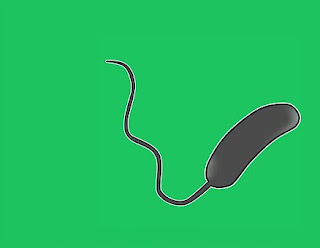What are Bacteria?
Bacteria-:
The bacteria are amongst the smallest organisms. They are most primitive, simple, unicellular, and micro organisms. All bacteria are structurally relatively, homogeneous, but their biochemical activities and ecological niches for which their metabolic specialisms equip them, they extremely diverse.
Bacteria
occur almost everywhere: in air, water, soil and inside other organisms. They are
found in stagnant ponds and ditches, running streams and rivers, lakes, sea
water, foods, petroleum oils from deeper regions, rubbish and manure heaps,
sewage, decaying organic matter of all types , on the body surface, in body
cavities and in the internal tracts of man and animals. Bacteria thrive well in
warmth, but some can survive at very cold tops of high mountains such as Alps
or even in almost boiling hot springs. They occur in vast numbers. A
teaspoonful of soil may contain several hundred million bacteria. They lead
either an autotrophic or heterotrophic mode of existence. The saprophytic or
saprophytic species of bacteria are of great economic significance for man.
Some parasites are pathogenic to plants, animals, and man.
Bacteria
have a high ratio of surface area of volume because of their small size. They
show high metabolic rate because they absorb their nutrients directly through
cell membrane. They multiply at a rapid rate. In consequence due to their high
metabolic rate of multiplication, bacteria produce marked changes in the environment
in a short period.
Size of Bacteria
Typically
bacteria range between 1 micrometer to 3 micrometer, so they are barely visible
under the light microscope. The smallest bacterium is Dialister pneumosintes (0.15
to 0.3 micrometer in length). The largest bacteria is Spirillum volutans (13 to
15 micrometer).
Forms of Bacteria
1.Cocci (singular coccus). These bacteria are spherical or round in shape. These bacteria cells may occur singly in pairs, in groups of four in a cubical arrangement of eight or more in irregular clumps resembling bunches of shapes
![What are [Bacteria]? what kinds of bacteria,](https://blogger.googleusercontent.com/img/b/R29vZ2xl/AVvXsEhrjQREqQgQXBrgwxP1CAjcx5UlzDNqB348ykrXf2Ux8uiin85VxdyPSICRs2y0Nuy4B8iPkHYC9hOxrxTgc-1pYKBVQjQq0S4pdqsiwcrc2tyY7E4MwdskLbX_aaE_y5IK_TQafPeZ1Amb/s400/bacteria-67791_960_720.jpg) |
| Cooci Bacteria |
2.Bacilli (singular, bacillus). These are rod like bacteria, They generally occuar singly, but may occasionally be found in pairs or chains . Bacilli cause certain most notorious diseases of man such as tuberculosis (mycobacterium or bacillus tuberculosis), tetanus (Clostridium tetani), typhoid (Salmonella or Bacillus typhous), Dephtheria (Coryne bacterium diphtheria), Leprosy (Mycobacterium leprae), dysentery and food poisoning (Clostridium botylinum).
Certain
well known diseases of the animals are also caused by bacilli, example anthrax
(Bacillus anthracis) and black leg (Clostridium chauvei).
3.Spirilla (singular, spirillum). These are also called spirochetes. These are spiral-shaped and motile bacteria. Spirilla cause human diseases such as syphilis (treponema pallidum).
![What are [Bacteria]? what kinds of bacteria?](https://blogger.googleusercontent.com/img/b/R29vZ2xl/AVvXsEjr0gE8G6oxaFuxzpdQ_pW89GmEFSjrfi7wJpjsU7cBjTiigUer-urn5zZy5p_owzS_dzcnO40cmShGtWhiZGDUXhSXuoiZ7-oPSbxdt-i_gIYE2T6FEuC8prnlF9j1-ATPVrrthJ0rUwZl/s320/GF94EY.jpg) |
| Spirilla Bacteria |
4.Vibrios (singular vibrio). These are comma shaped or bent- rod like bacteria. Vibrios cause human disease such as cholera (Vebrio cholera).
 |
| Vibrios Bacteria |
So
friends, I hope that you guys must have liked this information. And thanks a
lot to all of you guys for coming to my post.

![What are [Bacteria]? what kinds of bacteria?](https://blogger.googleusercontent.com/img/b/R29vZ2xl/AVvXsEi4Lc5hDhZmiowrmWyJR2u5aqDDhbaeon9vvwndMEGRGl2hefJdr09-teOD-jXeXiSLGcnOkWMSOzuf5cfkgHix59q6GGh_J8twWwza_Wb31uCC-GWFO7fUjsx0543wixbwKAfV6I_DT0FL/s640/bacteria-163711_960_720.jpg)
![What are [Bacteria]? what kinds of bacteria,](https://blogger.googleusercontent.com/img/b/R29vZ2xl/AVvXsEgaxWB2_DZoZccEw06wgTl21bZuLpIghsJ5IbchyPpjmgNq8yKl_aODnTJwaAe-pjiLV12OHpsOtyP5xrQ6KVTHzqBp-B5S2SDnXcvadDtxyYkiWWy9mYnQlqAGL6BlczU0QNnK0RVS-nRP/s400/bacteria-1832824_960_720.png)











![100 Best: [Instagram Captions] and [Instagram Quotes] For Influencers 2019](https://blogger.googleusercontent.com/img/b/R29vZ2xl/AVvXsEh_t4OSpj7NmzQIDz1KqVLZdUjpxKtJJATpwSDMRWCK0TkxrhYcythGhq8dy327DZ6app0bG1_Q4O4oRtM7FbHXom2R2vqtauFDf0bR3JsTRPlm0NA-rQZ5iT8curL51AMQ1b7GBJMVrFdk/w72-h72-p-k-no-nu/sunil_390x259.webp2.jpg)
![Fast [weight loss] diet plan](https://blogger.googleusercontent.com/img/b/R29vZ2xl/AVvXsEidHf5GrmN6alMJ4vUMO9sM9bKvpVRakWMZEM0pt5SUhACIN0jCTNjNtlik2KfAUMgd3jvJ4TpHrt5zSPs1s3VXuTWbv_mlaYpdhD85ZUGQSLmIqiIQdkzVTUjlnXB4FsV3k_Vh6mCMSnQy/w72-h72-p-k-no-nu/motapa_3.jpg)


![What is [Dropbox] and how we can use of it?](https://blogger.googleusercontent.com/img/b/R29vZ2xl/AVvXsEhkZtoBYMPjp4u2e9Av_fCyQbkYz6Vdb4gTz325_lyjDiXU4HpqBpTnU3rPuR0smqrImJJETomP4wEWmspivxzNRSF7YwwfOwmiEuuI45sl1dfGZZStaU_aqAs927IIl_rYvVH2outQf4qR/w72-h72-p-k-no-nu/download.png)
No comments:
Post a Comment